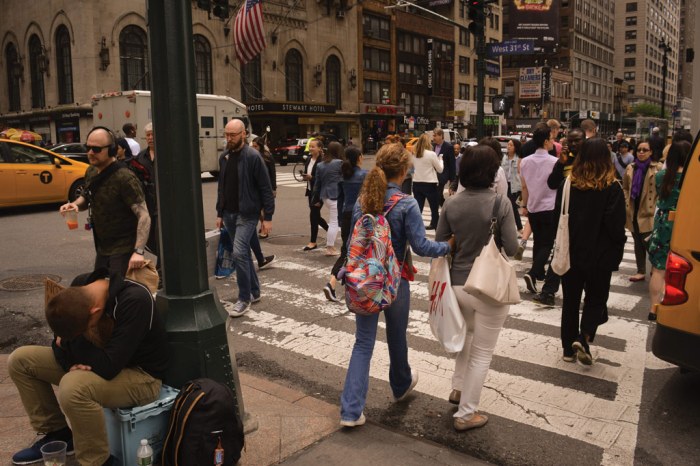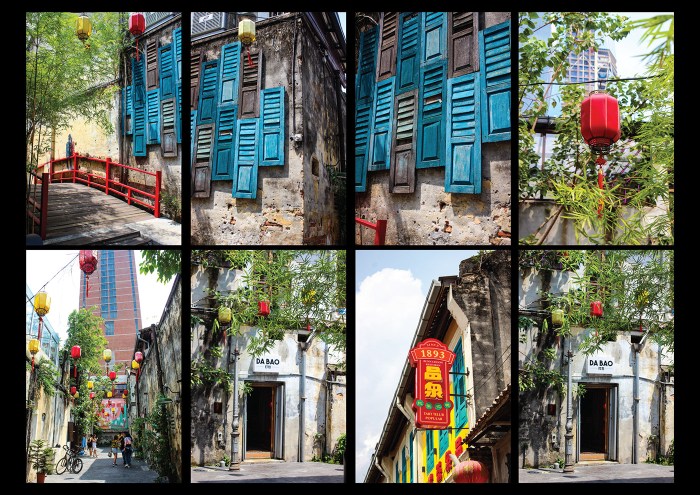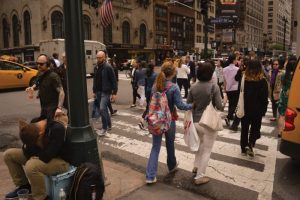
Street photography tours offer a unique blend of travel and artistic exploration, allowing participants to immerse themselves in the vibrant tapestry of urban life while honing their photographic skills. These tours provide more than just sightseeing; they offer structured learning experiences, expert guidance, and opportunities to capture compelling images in iconic locations. From mastering essential techniques to understanding ethical considerations, street photography tours cater to photographers of all skill levels, fostering creativity and a deeper appreciation for urban environments.
This guide delves into the multifaceted world of street photography tours, examining market trends, tour design, photography techniques, comparative niche travel experiences, and effective marketing strategies. It aims to provide a comprehensive resource for both aspiring tour operators and enthusiastic photographers seeking to embark on this enriching adventure.
Market Analysis of Street Photography Tours
The global market for street photography tours is experiencing significant growth, driven by the increasing popularity of photography as a hobby and the desire for unique travel experiences. This burgeoning market presents exciting opportunities for tour operators who can effectively tap into the demand for high-quality, immersive, and educational street photography excursions.
Current Market Size and Growth Potential
Precise figures for the global market size of street photography tours are difficult to obtain due to the fragmented nature of the industry. However, the overall growth of the experiential travel market, coupled with the rising popularity of photography workshops and tours, suggests substantial potential. We can infer growth by observing the increasing number of companies offering such tours, the expansion of their offerings into new cities and countries, and the consistently positive reviews and high demand visible on online booking platforms.
For example, the success of companies like “Capture the City” (a hypothetical example) which offers tours in multiple major cities, indicates a strong market demand. Their expansion from one city to five in just three years suggests a significant and rapid growth trajectory. Further, the increasing number of online photography communities and tutorials, indirectly fuels this demand.
Key Demographics of Interested Individuals
The primary demographic for street photography tours includes individuals aged 25-55, with a higher concentration in the 30-45 age bracket. This group often possesses disposable income, an interest in travel and photography, and a desire for engaging and educational experiences. Within this group, we see a significant representation of both amateur and intermediate-level photographers seeking to improve their skills and expand their creative horizons.
Furthermore, there’s a growing segment of experienced photographers looking for unique locations and guided perspectives to enhance their photographic journeys. Solo travelers, couples, and small groups represent the common booking patterns.
Pricing Strategies of Street Photography Tour Operators
Pricing strategies vary significantly depending on factors such as tour duration, location, instructor expertise, and included amenities. Some operators adopt a premium pricing model, emphasizing small group sizes, expert instruction, and high-end equipment. Others opt for a more budget-friendly approach, focusing on larger group sizes and a more basic level of instruction. A common pricing strategy involves tiered packages, offering different levels of service and inclusions at varying price points.
For example, a basic tour might cost $100, while a premium tour with personalized feedback and post-processing guidance could cost $300. The pricing often reflects the perceived value proposition, with higher prices justified by superior instruction, exclusive access, or more personalized attention.
Marketing Channels Used by Successful Businesses
Successful street photography tour businesses leverage a multi-channel marketing strategy. Social media platforms like Instagram and Facebook play a crucial role in showcasing stunning photography, highlighting tour highlights, and engaging with potential customers. Collaborations with travel bloggers and photography influencers can significantly boost brand awareness and reach a wider audience. Search engine optimization () and targeted online advertising are also essential for driving organic traffic and attracting potential customers through search engines.
Finally, partnerships with local businesses and tourism boards can provide additional marketing opportunities and reach new customer segments.
SWOT Analysis for a Hypothetical Street Photography Tour Company
| Strengths | Weaknesses |
|---|---|
| Experienced and passionate instructors | High dependence on favorable weather conditions |
| Unique and exciting tour locations | Potential for high customer expectations |
| Strong online presence and social media engagement | Limited scalability in the short term |
| Opportunities | Threats |
| Expansion into new cities and countries | Competition from other tour operators and workshops |
| Development of specialized tours (e.g., night photography) | Economic downturns affecting travel spending |
| Partnerships with photography equipment brands | Changes in social media algorithms impacting reach |
Tour Design and Itinerary Development
Crafting a successful street photography tour requires meticulous planning and a deep understanding of both the photographic opportunities and the logistical challenges involved. A well-structured itinerary, coupled with careful consideration of participant needs and potential hurdles, is crucial for a positive and productive experience. This section details the design process, focusing on a sample itinerary, logistical considerations, essential equipment, guiding best practices, and incorporating storytelling elements.
Sample 3-Day Street Photography Tour Itinerary: New York City
This itinerary focuses on diverse photographic opportunities across New York City, catering to varying skill levels. Each day emphasizes a different photographic theme and location, maximizing learning and creative expression.Day 1: Greenwich Village & SoHo – Exploring architectural details, street life, and candid moments. Morning session focuses on capturing the vibrant street life and architectural details of Greenwich Village, with opportunities for candid portraiture.
The afternoon session shifts to SoHo, highlighting the unique cast iron architecture and fashion-forward street style.Day 2: Chinatown & Little Italy – Immersing in cultural richness and diverse perspectives. The morning explores the bustling streets and vibrant markets of Chinatown, emphasizing capturing textures, colors, and cultural nuances. The afternoon focuses on Little Italy, capturing the charm of its historic streets and the energy of its local businesses.Day 3: Central Park & Times Square – Contrasting environments and capturing the essence of New York.
The morning session in Central Park provides opportunities for landscape, portrait, and candid photography, showcasing the park’s diverse environments. The afternoon in Times Square offers a stark contrast, emphasizing capturing the energy and chaos of this iconic location. Participants will learn to navigate high-contrast situations and capture compelling images in a dynamic environment.
Logistical Considerations for Street Photography Tours
Planning a street photography tour necessitates addressing several key logistical elements to ensure a smooth and enjoyable experience for participants. Permits might be required for specific locations, especially if using tripods or engaging in commercial photography. Transportation arrangements, including group travel to and from locations and potential transportation during the tour, need careful planning. Comfortable and centrally located accommodation is crucial, considering proximity to shooting locations and participant convenience.
Contingency plans for inclement weather should also be in place. Detailed communication with participants before and during the tour is essential to address any queries or concerns promptly.
Essential Equipment and Supplies for Participants
Participants should be well-prepared with appropriate equipment and supplies. A high-quality camera, whether DSLR or mirrorless, is essential. A variety of lenses, including a wide-angle lens for capturing expansive scenes and a telephoto lens for compressing perspectives and isolating subjects, is recommended. Extra batteries and memory cards are crucial to avoid interruptions. Comfortable walking shoes are a must, as street photography involves considerable walking.
A small backpack to carry equipment and personal items is also advisable. Finally, a notebook and pen for jotting down ideas and observations will enhance the learning experience.
Best Practices for Guiding Participants
Effective guidance is key to maximizing participant learning and photographic results. Start with clear instructions and demonstrations of basic techniques. Encourage exploration and experimentation, fostering individual creativity while providing constructive feedback. Offer personalized guidance based on individual skill levels, addressing both beginners and more experienced photographers. Provide opportunities for peer-to-peer learning and interaction.
Regular breaks for discussion and image review are essential. Emphasize ethical considerations in street photography, including respecting privacy and obtaining consent where appropriate.
Incorporating Storytelling into Street Photography Tours
Street photography is not merely about capturing images; it’s about conveying stories and emotions. The tour can be designed to guide participants in identifying and documenting narratives within their chosen locations. This can involve assigning themes or prompts, encouraging participants to focus on capturing specific emotions or aspects of daily life. Post-photography discussions can focus on analyzing the narrative elements within captured images, exploring how composition, lighting, and subject matter contribute to storytelling.
Encouraging participants to share their personal interpretations of their images further enhances the storytelling aspect of the tour.
Photography Techniques and

Street photography demands a unique blend of technical skill, artistic vision, and ethical awareness. Mastering these elements allows photographers to capture the vibrant pulse of everyday life, transforming fleeting moments into compelling narratives. This section delves into the essential techniques, equipment choices, and ethical considerations that underpin successful street photography.
Composition in Street Photography
Effective composition is paramount in street photography. It guides the viewer’s eye, creates visual interest, and conveys the photographer’s intended message. Common compositional techniques include the rule of thirds, leading lines, framing, and symmetry. The rule of thirds involves placing key elements off-center, creating a more dynamic and engaging image. Leading lines, such as roads or fences, draw the viewer’s gaze into the scene.
Framing uses elements within the scene, like doorways or arches, to isolate and highlight the subject. Symmetry, while less common in chaotic street scenes, can create a powerful sense of balance and order when found. Consider the interplay of negative space as well; it can be just as crucial as the subject itself in defining the mood and message of the photograph.
Lighting in Street Photography
Light is the sculptor of a photograph, shaping form and mood. Street photographers must be adept at recognizing and utilizing different lighting conditions. Golden hour, the period shortly after sunrise and before sunset, provides warm, soft light ideal for creating evocative portraits and scenes. Harsh midday sun can create strong shadows, which can be used creatively to add drama or texture, or avoided entirely by shooting in shaded areas.
Overcast days provide soft, diffused light, excellent for evenly lit images. Understanding how light interacts with your subject and the environment is key to capturing compelling street photographs. Experiment with backlighting to create silhouettes or rim lighting to highlight edges.
Interaction with Subjects
The interaction, or lack thereof, between the photographer and their subjects is a defining characteristic of street photography. Candid photography, capturing subjects unaware, often yields spontaneous and authentic moments. However, ethical considerations (discussed later) must always be prioritized. Environmental portraits, on the other hand, involve a degree of interaction, often subtly integrating the subject into their environment. This might involve brief eye contact or a gesture to indicate you’re taking their picture, or it might simply involve carefully positioning yourself to capture a meaningful interaction within a scene.
The approach depends on the photographer’s style and the specific situation.
Photographic Approaches in Street Photography
Several approaches define street photography. Candid shots, as mentioned, capture subjects without their knowledge, resulting in unposed, natural expressions. Environmental portraits, as discussed, place the subject within their surroundings, creating a context that reveals more about their personality and environment. Street scenes encompass broader perspectives, capturing the overall atmosphere and activity of a location. These scenes might include a wide range of subjects and activities, creating a vibrant tapestry of urban life.
Each approach requires a different level of interaction and a unique perspective.
Camera Settings and Equipment Choices
A fast lens (wide aperture like f/1.4 or f/2.8) is beneficial for street photography, allowing for shallow depth of field and faster shutter speeds to freeze motion. A wide-angle lens (28mm or 35mm equivalent) is often preferred for capturing a broader perspective, while a longer lens (50mm or 85mm) allows for more compressed perspectives and better isolation of subjects.
High ISO performance is crucial for shooting in low light conditions. Continuous shooting mode helps capture fleeting moments. Many photographers prefer mirrorless cameras for their silent operation and live view functionality, enabling discreet shooting.
Post-Processing Techniques for Street Photography
A dedicated workshop module on post-processing could cover adjusting exposure, contrast, and white balance; using selective editing tools to enhance specific elements; managing noise and sharpening images; and converting to black and white to emphasize texture and form. Specific software such as Adobe Lightroom or Capture One could be introduced, along with techniques for cropping, straightening, and retouching. Emphasis should be placed on maintaining the integrity and authenticity of the original image while enhancing its visual impact.
Ethical Considerations in Street Photography
Respecting privacy is paramount. While candid photography is a staple of the genre, it’s crucial to be mindful of potentially intrusive situations. Avoid photographing individuals in vulnerable or compromising situations. Consider the potential impact on the subject and their privacy. In some cases, obtaining consent, while not always legally required, can foster trust and improve the ethical standing of the work.
Always consider the potential consequences of your actions and the potential impact your photography might have on individuals and communities.
Comparison with Similar Niche Travel Experiences
Street photography tours occupy a unique niche within the travel industry, sharing similarities with, yet also differing significantly from, various other specialized travel experiences. Understanding these comparisons helps to define the target audience, refine tour design, and effectively market the tours. The following analysis explores these relationships.
Street Photography Tours Compared to Religious Pilgrimages
Religious pilgrimages and street photography tours, while seemingly disparate, share a common thread: a journey driven by a profound, albeit different, form of seeking. Pilgrimages center around spiritual fulfillment and connection to faith, often involving structured rituals and visits to sacred sites. Street photography tours, conversely, focus on artistic exploration and personal growth through visual storytelling, with the urban landscape acting as the “sacred” space.
Experience design differs drastically; pilgrimages emphasize reverence and communal prayer, while photography tours prioritize individual creative expression and technical skill development. Participant motivations are distinct – spiritual enrichment versus artistic achievement.
Street Photography Tours Compared to Wildlife Watching Tours
Both street photography tours and wildlife watching tours involve observation and documentation of subjects within their natural habitats. However, logistical challenges differ significantly. Wildlife tours often require extensive travel to remote locations, specialized equipment (e.g., binoculars, telephoto lenses), and adherence to strict environmental regulations. Street photography tours, while requiring navigation of urban environments, typically involve less extensive travel and more accessible locations.
Environmental impact is another key difference; wildlife tours can potentially disturb animal behavior and habitats, demanding careful planning and responsible conduct. Street photography tours, while potentially impacting local communities through increased foot traffic, generally have a less pronounced environmental footprint.
Street Photography Tours Compared to Winter Sports Trips
Seasonality is a major differentiating factor. Winter sports trips are inherently seasonal, limited to periods with sufficient snow and ice. Street photography tours, while potentially influenced by weather conditions, are less constrained by specific seasons, offering year-round opportunities with varying photographic conditions and subject matter. Target audiences also differ; winter sports trips appeal to adventure-seekers and athletes, while street photography tours attract individuals with an interest in photography, urban culture, and visual storytelling.
The skill sets required also differ dramatically, with winter sports emphasizing physical fitness and specialized techniques, while street photography requires photographic skills and observational acumen.
Street Photography Tours Compared to Island Hopping Tours
Itinerary planning and photography opportunities present key differences. Island hopping tours typically involve pre-planned itineraries across multiple islands, often focused on relaxation, beach activities, and cultural exploration. Street photography tours, while potentially incorporating elements of cultural exploration, primarily focus on capturing urban scenes and street life within a specific city or region. Photography opportunities are vastly different; island hopping provides opportunities for landscape, seascape, and wildlife photography, while street photography emphasizes candid portraits, street scenes, and urban textures.
The pace and structure of the itineraries also differ significantly, with island hopping often more relaxed and flexible compared to the more structured approach of street photography tours.
Comparison of Street Photography Tours with Various Niche Travel Experiences
| Tour Type | Participant Motivation | Logistical Challenges | Unique Aspects |
|---|---|---|---|
| Voluntourism | Giving back to communities while traveling | Matching skills with needs, cultural sensitivity | Combines social impact with travel |
| Photography Tours (General) | Improving photographic skills, capturing specific subjects (landscapes, wildlife, etc.) | Access to locations, equipment management | Focus on technical skills and specific subject matter |
| Festival Travel | Experiencing cultural events, music, and performances | Ticket acquisition, accommodation during peak season | Immersive cultural experience, vibrant atmosphere |
| Desert Expeditions | Adventure, exploration, unique landscapes | Extreme weather conditions, navigation, safety | Unique landscapes, challenging environment |
| Underwater Adventures | Exploring marine life, diving/snorkeling | Diving certification, equipment, marine safety | Unique underwater perspective, marine wildlife |
| Art and Architecture Tours | Appreciating art and architecture, learning about history and culture | Access to museums/sites, scheduling | Focus on artistic and historical appreciation |
Marketing and Promotion of Street Photography Tours
Successfully launching a street photography tour business requires a well-defined marketing strategy that targets the right audience, utilizes effective channels, and conveys the unique value proposition of the experience. This involves a multi-faceted approach encompassing social media engagement, visually compelling promotional materials, and leveraging influencer marketing to reach a wider audience.
Target Audience Identification and Messaging
Identifying the target audience is paramount. Our primary target audience comprises amateur and intermediate photographers aged 25-55, with a passion for travel and photography. They are likely to be digitally savvy, active on social media platforms, and interested in unique travel experiences. Secondary audiences include photography enthusiasts seeking workshops, travel bloggers, and individuals looking for engaging city tours with a creative twist.
Messaging should emphasize the blend of cultural immersion, photographic learning, and personalized exploration. For example, we could use slogans like “Capture the City’s Soul,” “Unlock Your Inner Street Photographer,” or “Urban Exploration Through the Lens.” Tailoring messaging to each audience segment will enhance effectiveness.
Channel Selection and Marketing Plan
A multi-channel approach is crucial. Our marketing plan will focus on:
- Social Media Marketing: Instagram, Facebook, and Pinterest will be primary channels, showcasing high-quality images and videos from past tours. Targeted advertising campaigns on these platforms will reach potential customers based on their interests and demographics.
- Website and Blog: A visually appealing website with high-resolution photography, tour itineraries, testimonials, and a blog featuring photography tips and behind-the-scenes glimpses will serve as a central hub for information and booking.
- Search Engine Optimization (): Optimizing website content and utilizing relevant s will improve organic search rankings, increasing visibility to potential customers searching online for street photography tours.
- Partnerships and Collaborations: Collaborating with travel agencies, hotels, and local businesses will expand reach and create cross-promotional opportunities.
- Email Marketing: Building an email list through website sign-ups and social media campaigns will allow for targeted communication of promotions and new tour offerings.
Engaging Social Media Content
Social media content should be visually stunning and engaging. This includes high-quality images and short videos showcasing the vibrant street scenes, participants’ work, and the unique atmosphere of the tours. Behind-the-scenes stories, tips from the photographer guide, and user-generated content (reposting photos from participants) will foster a sense of community and encourage engagement. Instagram stories and reels, featuring quick snippets of the tour experience, will be utilized to create a sense of immediacy and excitement.
Regular contests and giveaways will further boost engagement.
Visually Appealing Brochure and Website Design
The brochure and website should reflect the brand’s aesthetic and showcase the tour’s unique aspects. High-quality images from past tours, testimonials from satisfied participants, and clear information on tour itineraries and pricing are essential. The design should be clean, modern, and visually appealing, reflecting the creative nature of street photography. A consistent brand identity across all marketing materials is crucial for brand recognition.
For instance, the website could feature a captivating slideshow of photos from previous tours, each with a short caption highlighting the location and a specific photographic element. The brochure could similarly showcase stunning images, a concise tour description, and booking information.
Influencer Marketing
Partnering with relevant travel and photography influencers can significantly expand reach and credibility. Selecting influencers with a genuine interest in street photography and a strong engagement rate is key. Collaborations could involve sponsored posts, Instagram takeovers, and participation in the tour itself, generating authentic content. For example, a collaboration with a travel blogger specializing in urban exploration could involve them participating in a tour and creating a blog post and social media content showcasing the experience.
The success of such campaigns will be tracked through increased website traffic and bookings.
Examples of Successful Marketing Campaigns
Successful marketing campaigns for similar niche travel experiences often emphasize visual storytelling and community building. For example, a popular photography workshop company in Iceland uses stunning landscape photography on their website and social media, highlighting the unique locations and creating a sense of adventure. Another example is a food tour company that uses mouth-watering images and videos of the food and cultural experiences, creating a sense of excitement and anticipation.
These campaigns successfully leverage high-quality visuals, user-generated content, and strategic partnerships to build brand awareness and drive bookings.
Closure

Ultimately, street photography tours represent a dynamic and growing niche within the travel industry, offering a unique fusion of artistic expression, cultural immersion, and personal growth. By understanding the market dynamics, mastering photographic techniques, and employing effective marketing strategies, tour operators can create unforgettable experiences for participants, fostering a thriving community of street photographers and enriching the way we perceive and document urban life.
The careful consideration of ethical practices and logistical planning is key to ensuring both a successful business and a rewarding experience for all involved.
Clarifying Questions
What kind of camera equipment is recommended?
A DSLR or mirrorless camera with interchangeable lenses is ideal. A versatile zoom lens (e.g., 24-70mm) is highly recommended, along with a prime lens (e.g., 35mm or 50mm) for superior image quality.
What if I’m a beginner photographer?
Many tours cater to all skill levels, including beginners. Experienced instructors provide guidance and tailored instruction to help participants develop their skills throughout the tour.
Are there any age restrictions?
Age restrictions vary depending on the tour operator and specific itinerary. Some tours may be suitable for all ages, while others might have minimum age requirements.
What about travel insurance?
Comprehensive travel insurance is strongly recommended to cover unforeseen circumstances, such as medical emergencies, trip cancellations, or lost equipment.





